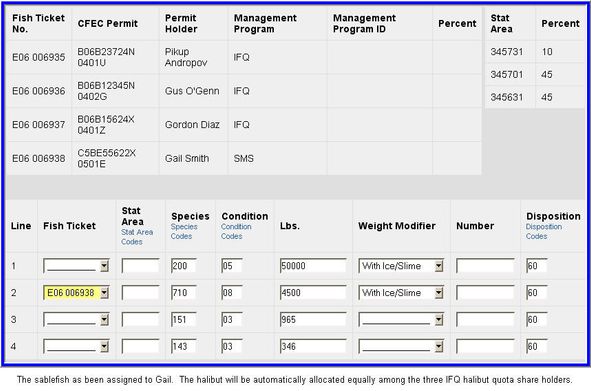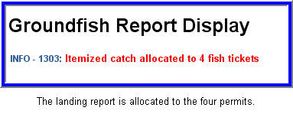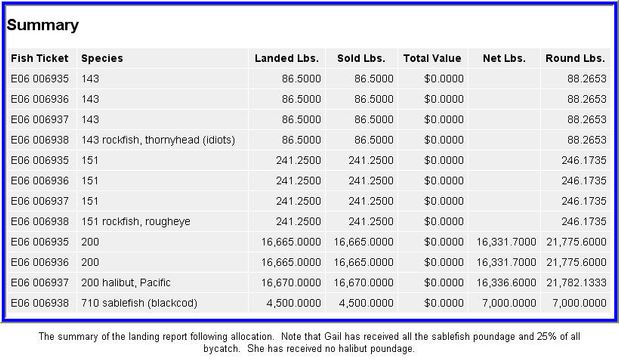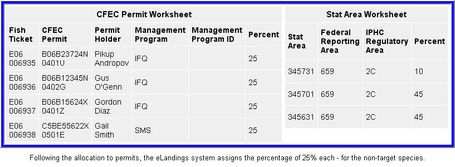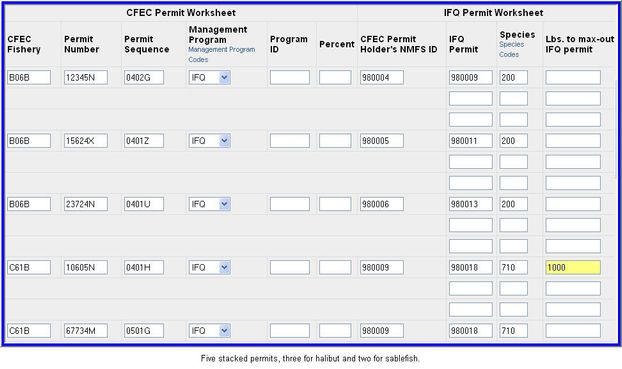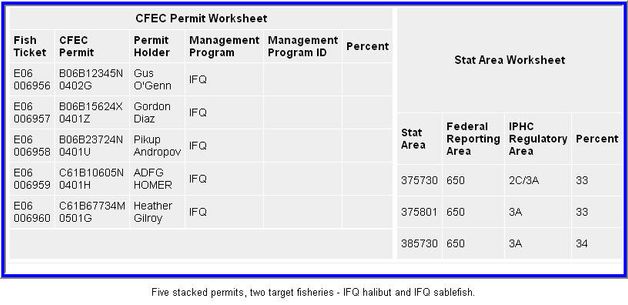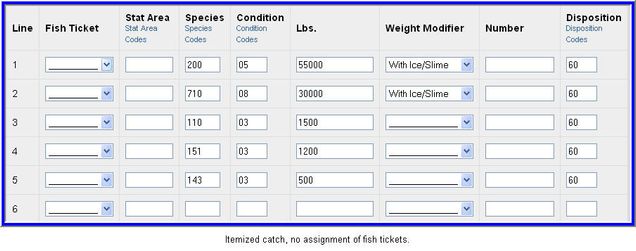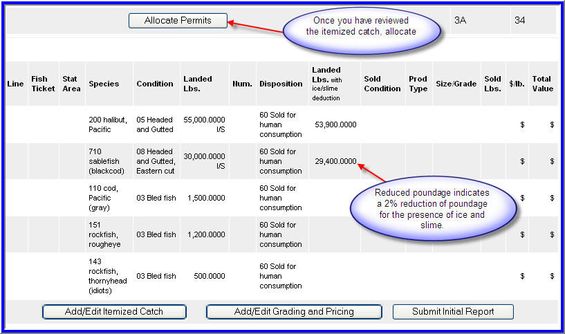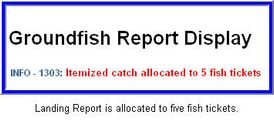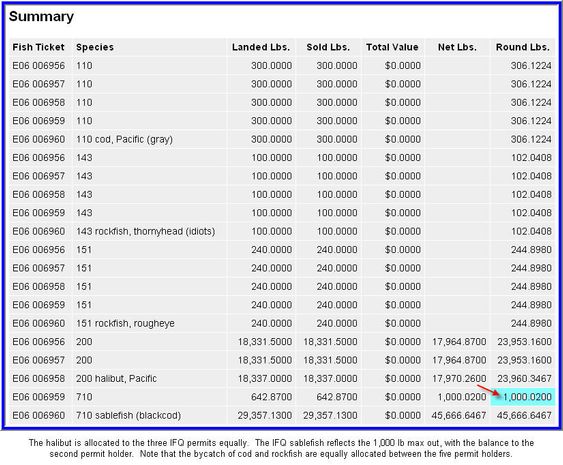The purpose of this section is to provide examples and instructions for using the eLandings allocation process. It is also meant to demonstrate allocation of catch and bycatch when landings include the following:
— Stacked permits
— Multiple target species.
Example 1: Three Stacked Permits
The target species in this example are IFQ halibut and IFQ sablefish. You're looking at a report in which the Vessel, Permit, Location information has already been entered.
As you can see, there are three IFQ permits in our example. Our goal is to allocate the halibut IFQ percentages between the two permit holders. Sara Sable gets 80% of the catch while Hal Halibut receives 20%.
Gale Storm will receive the entire amount IFQ sablefish pounds as she is the only IFQ sablefish permit holder.
All documented bycatch will be automatically allocated to the two halibut fishers in the same 80/20 split. Gale will not receive any bycatch allocation automatically.
The CFEC Permit Worksheet was designed to allocate a single primary target species to multiple permit holders, determined by the percentages entered in the worksheet.
- This means that the CFEC Permit Worksheet percentages must add up to 100%.
- If you do not enter percentage allocations for catch, the system will split the allocation equally among permit holders.
- You can use the CFEC Permit Worksheet for multiple targets/species, but you will need to make additional edits.
In the example below, Gale receives 5,200 lbs of sablefish. Sara and Hal get an 80/20 split of 5500 pounds of halibut. Hal has also decided that he would like 100 pounds of halibut for personal use.
Note the Fish Ticket column with the down arrow. This indicates a drop down menu to select a specific fish ticket. When a fish ticket is assigned, all the harvest for that line item is allocated to a single permit. The default is no assignment of a fish ticket number. The eLandings application automatically allocates the catch by the percentage established inthe CFEC Permit Worksheet. Again, if no percentage is established, the itemized catch is allocated equally.
When the total itemized catch by species/deliverycondition/disposition code categories are complete, save this portion of the report.
You can now proceed with adding size/grade/price information or allocate catch to the three permits.
When you select to allocate the permits, the catch is split out as illustrated below. Note that Heather has received no allocation of bycatch. Her allocation of rougheye, shortraker, and thornyhead is zero pounds.
Below the itemized catch by line item is the current statusdisplay of the landing report summary. This summary also reflects zero poundsof bycatch for Heather on fish ticket number E06 006910.
The eLandings application allows reallocation of itemized catch by going back to the Add/Edit Itemized Catch page. It is advisable to perform this function prior to Initial Submission of the landing report.
In this example, Heather wants to receive a portion of the sold bycatch.
Once the edited version of the itemized catch portion of the landing report is saved, the Summary now reflects the modification in there-assignment of bycatch poundage.
If all fishers are in agreement with the allocation of poundage, the report can be submitted.
Once the report has been successfully saved and initially submitted,fish ticket PDF files are created. The text color of the fish ticket number inthe CFEC Permit Worksheet transforms to blue, indicating a link.
Select the individual fish ticket number. This opens AdobeAcrobat, allowing you to display for printing the completed ADF&G FishTicket. Below the landing report Summary, you will find the IFQ portionsection of eLandings. You are now ready to submit the IFQ report.
Example 2: Stacked Permits & Multiple Target Species
This example combines stacked permits together with multipletarget species - IFQ and non-IFQ target species. Like the first example, we start with a landing report where the vessel, permit, and Location information have already been entered.
You can see that there are 4 CFEC permit holders. But no percentages have been established in the CFEC Permit Worksheet. The management program assignments are IFQ and the State Managed Sablefish fishery (SMS).
In the Add/Edit Itemized Catch page, the sablefish catch isassigned solely to fish ticket number E06 006938. The halibut catch will be equally distributed among the three IFQ halibut quota share holders. The bycatch will be allocated equally among all four permit holders.
Once the Itemized Catch is saved, the permits can be allocated.
Here is the landing reports Summary section after the allocation.
Following the allocation the eLandings system assigns the percentage of 25% each for the non-target species.
If the permit holders want to reassign all or a portion of the poundage, it is very simple to once again return to Add/Edit ItemizedCatch. Once the catch has been satisfactorily allocated, the itemized catch can be saved. The poundage is assigned to the individual fish ticket.
The landing report can be initially submitted, allowing theprinting of fish tickets and the generation and submission of the IFQ reports. If grading/sizing/pricing information is available, it may be added to the landing report, prior to the initial submission.
Example 3: Stacked Permits & Multiple Target Species using Max OutPounds
This third example again illustrates a situation where there are stacked permits and multiple target species. In this case there is IFQ halibut and IFQ sablefish and we are going to use the Max out of pounds function.
Five IFQ quota share holders join together to fish - three halibut permits and two sablefish permits. One IFQ sablefish permit has 1,000 lbs remaining on the permit. The five permits are recorded in the Vessel, Permit, Location Information section of theeLanding report. Note the 1,000 lb max out.
The Vessel, Permit and Location information (often referred to as the 'header' section of the landing report)is saved.
The itemized catch is next recorded by species, delivery condition, and disposition. The scale weight is recorded for each item.
The landing report is saved andready for allocation.
The landing report catch is allocated to five fish tickets.
The eLandings systemautomatically allocates the harvest as follows:
If the allocation is acceptableto all five permit holders, the Landing Report can be submitted and the IFQ reporting completed.
If you want to reallocate the pounds, return to the Itemized Catch section of the landing report, modify the poundage and save. If you add an additional item or items, you will be required to assign the individual line item to a specific fish ticket number.
When the allocation iscompleted, you can proceed with the IFQ reporting process.












